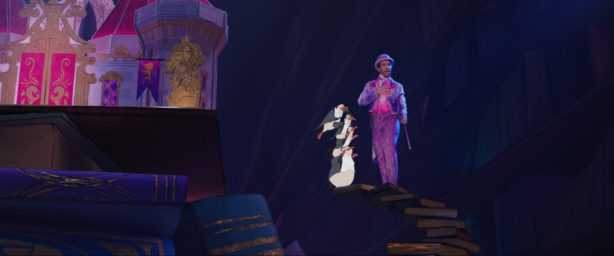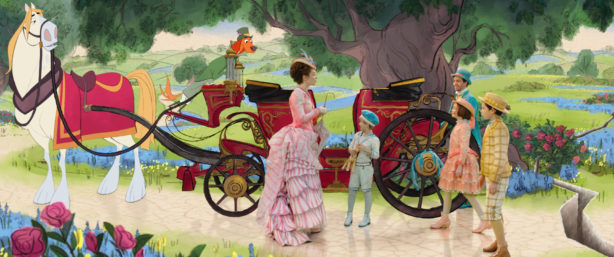The adventures of Mary Poppins continue with a new generation of Banks children in Disney’s Mary Poppins Returns, which pays tribute to one of the 1964 film’s most memorable sequences in a colorful marriage of live action and animation that takes viewers to the “simply sensational standing-ovational Royal Doulton Music Hall” for a breathtaking musical number. Harking back to Mary Poppins’ “Jolly Holiday,” which saw Mary Poppins, chimney sweep Bert and her young charges leap into a chalk illustration drawn upon the sidewalks of London, in Mary Poppins Returns the beloved nanny leads the way to another unlikely world, one that exists within an exquisitely painted Royal Doulton china bowl found inside the house on Cherry Tree Lane. While new technology has enabled motion picture animation to advance markedly over the last 54 years, a team comprised of both seasoned and emerging animators came together to create this stunning two-dimensional world.
Animation Sequence Supervisor Jim Capobianco, a veteran of both Pixar and Walt Disney Animation Studios, shares that he was considered the go-to “2-D guy” during his time at Pixar, where he counts among his credits the original story for Ratatouille, as well as two-dimensional projects that include the short Your Friend the Rat (from the home entertainment release of Ratatouille) and the credits for WALL•E. Some movie matchmaking brought together Capobianco and Mary Poppins Returns director Rob Marshall, who saw the opportunity for an approach that would use traditional, hand-drawn animation to deliver something that retained the nostalgia of the 1964 film, but felt fresh and different from what had been done before.

“I think 2-D animation has a magical quality to it. It’s so different from the rest of the movie in the sense that you’re losing a dimension,” Capobianco says. To create a visual language to convey to audiences that they have journeyed to another world, the animation team drew upon the research skills that Pixar and Disney animators are known for. The team studied Royal Doulton china, 1930s-era English music halls and even penguins, as they designed an animated world in which Emily Blunt, Lin-Manuel Miranda and the young Banks children could move within seamlessly.
The animation team consisted of both veteran animators who had worked on classics such as Beauty and the Beast and The Lion King—several of whom came out of retirement for the chance to be part of a brand-new movie featuring Mary Poppins—as well as younger artists who share Capobianco’s commitment to keeping the world of 2-D animation alive. The process began just as it did in 1964, on paper, and continued for Capobianco in a fashion that transported him to an earlier time, as well.
“In the initial stages of developing the animation, I would bring the storyboards down to Disney and I would meet Rob there and pitch the sequence in the Hyperion Bungalow,” Capobianco recalls. Surrounded by Disney history, “We would pin up the drawings and I would go through the sequence in the room to everybody, live,” he continues. With director Marshall, screenwriter David Magee and composer Marc Shaiman in the bungalow—and a piano on hand, as well—these review sessions would lead to spontaneous collaboration as the artwork inspired rewrites to the music and the script. “It felt very much as close as we could possibly get to the Sherman brothers working with Walt and Don DaGradi and that whole team. In a way, we went back to the way the original was made, in that sense,” Capobianco shares.

Modern innovations intended to streamline the animation process created unexpected hurdles for the animators, who had to discover new ways to integrate their “analog” style of animation into a digital world. “We had to work out new pipelines,” says Capobianco, who compared the challenge to using a combustion engine in a world largely populated with electric cars. The animators were able to use digital technology to their advantage, however, to shift characters within a frame, or duplicate parts of the animation when necessary. “There are a lot of characters and there’s a lot going on, and today’s technology does allow us to fill [the animation] out a little more,” Capobianco explains.
For the animators, it was both thrilling and a little daunting to bring classic animation to a modern motion picture. “I think everybody was excited to be part of making another film that could stand with the original film,” says Capobianco, who believes that their trepidation fueled the quality of the animation they created for the new film—which honors the legacy of the original film and creates movie magic that will endure long after the wind changes.